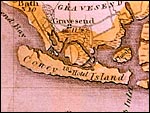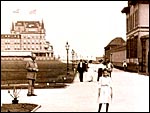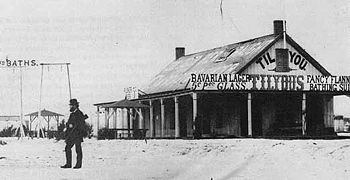History of Coney IslandFrom The Peopling of New York CityIntro and the Built Environment History of Coney Island Demographics and Economy Recent News Picasa Gallery
Overview of HistoryConey Island history is a fascinating collection of events dating all the way back to the exploration and expansion era. When Henry Hudson first sighted the beach at Coney Island in early September 1609, the land was nothing more than desolate sand dunes, clam beds and wind blown scrub that stretched for five miles along the shore of the Atlantic Ocean. It was a mere sand-spit just beyond lower New York Bay about five miles south of Manhattan in what would become known as Brooklyn. How Coney Island Got Its NameIn 1645, Dutch officials offered to let a group of English religious dissenters from New England, led by Lady Deborah Moody, establish a colony at Gravesend near the beach. They decided that the colony would be a buffer for them from the Indians who used the beach to collect clams and wampum, a type of currency. The land was called "Konijn Hok," the rabbit's hutch or breeding place, a pun on the fact that genuine rabbits or “coneys” shared the beach with the Native Americans.[1] Lady Moody guided and shaped the colony at Gravesend along tolerant and almost socialist lines during its first sixteen years. It was a primitive democracy with all decisions made at town meetings. The colony was blessed with fairly fertile farmland and a considerable amount of neglected seaside property that would eventually become the site of the most famous summer playground in the world. On May 7, 1654 a Native American named Guttaquoh, declared himself to be the owner of "Coyne Island", and formally put his mark on a deed conveying the Island to the forty Gravesend patentees. Unfortunately the local Native Americans were completely wiped out in 1655 by the rival Mohawk Indians for failing to pay tribute to the Five Nations. Being poor and under-armed, they mistakenly believed that the Dutch would protect them. The original Dutch name "Konijn Kok" first evolved to "Conyne Island" by the English and was later revised to Coney Island. However, there are other explanations of the origins of the name. Judge Egbert Benson, in a report to the New York Historical Society in 1816, argued that "Coney" came from "Conyn" the name of a Dutch family that once lived at the beach. Some believe that the area was named after John Colman, the officer aboard Hudson's "Half Moon" ship, who was killed by the Indians. The name eventually evolved into Coney Island. [2] Meanwhile, the English were in the midst of a series of Anglo-Dutch wars raging in Europe. On orders of Charles II, they surprised the Dutch by surrounding New Amsterdam with a British fleet boasting 120 guns and 500 veteran troops. Since the Dutch defenses included only 20 cannon and 250 soldiers and militia, the townspeople implored the governor to avoid bloodshed and destruction. Luckily for the citizens of Gravesend, who thought their tiny war was imminent, England took possession of New Amsterdam on September 5, 1664. Gravesend won possession of all of Coney Island without firing a shot.
How Coney Island Became a Summer ResortDuring the early 19th century there was considerable discussion among the community of building a shell road across the creek to the nearby beach. In 1823, Supervisor Terhune and others formed the Coney Island Road and Bridge Company as a private enterprise. They sought funding through a stock issue of 300 shares at $20 / share. The shares were purchased quickly and in 1829 the company built the Shell Road across the creek that separated Coney Island from the mainland. They also built a hotel called the Coney Island House, which marked the beginning of summer resort business. The Coney Island House existed where the "Thunderbolt" ride exists today. [3]During the early 1840's John Wyckoff, an elderly Gravesend schoolmaster opened a hotel to rival the Coney Island House. His hotels and one or two others catered to visitors wealthy enough to own carriages. Some of these hotels were especially prone to fire and burned down within a year or two of being built. The Coney Island House and various other hotels attracted many notables during the late 1840's. All three of the great pre-Civil War politicians, Daniel Webster, John C. Calhoun and Henry Clay stayed at Coney Island House. Other visitors included General Sam Houston and New York's Governor Edwin Morgan. Visitors watched the waves from comfortable porch chairs, ate clam chowder, went for a quick dip in the ocean surf or went snipe or duck hunting in the nearby marshes. Unfortunately this area also attracted a rougher element. Political and other groups found the Point ideal for outings that encouraged heavy drinking and fighting. Gamblers, attracted by the moneyed crowd, set up three-legged tables where they plied on the gullible in often crooked "skin" games of thimblerig, the old shell game, three card monte, and chuck-a-luck, a game using dice. The wealthier guests at the hotels in the center of the island were appalled by the lower classes that frequently visited the area. Salt Water BathingSalt-water bathing was a rather novel idea in the late 1860's and 1870's. It was an era when at best the closest city people came to voluntarily getting wet was the Sunday hot bath. Those that came to the beach were apprehensive of even sticking their toe into the sea for there were those that warned that sea bathing might "leach away the essential salts of the body." Overton's 1883 Coney Island Directory laid down the rules for bathing. "The dress should consist essentially of two parts - a pair of pantaloons and a blouse; the latter should not fit too tightly, the sleeves fastened loosely at the wrist and slits cut in the garment just below the armpits; a belt attached to the blouse to retain it at the waist. The pantaloons should not be buttoned too tightly to the ankles, as circulation would thereby be impeded. Men were urged to enter the water resolutely and briskly, until the water reaches the waist... If you can swim three strokes without going under, it is a fair start." Women, however, were warned of the danger of hysteria if they entered the surf abruptly. Surprisingly only a small percentage drowned given the fact that a full length woman's woolen swim suit when wet must have weighted at least fifteen pounds. The beach at Coney Island Point was booming because it was close to Manhattan by boat and it attracted numerous visitors, who frequented the beach on summer weekends. [4]
Development of HotelsDuring the next three years, business men, notably William Engeman who acquired the title to Brighton Beach, and August Corbin, a rich banker who acquired title to Manhattan Beach, decided to develop their respective property. Corbin sought a virgin tract of land east of West Brighton to build his hotels. Corbin's Manhattan Beach Hotel was built on the far eastern shore of Coney Island. It was considered the most elegant and fashionable hotel in the United States. It featured 258 lavish rooms, restaurants, ballroom and shops. The second resort that came into existence about the same time was William A. Engeman's Brighton Beach, located west of Manhattan Beach. To put together the land deal to build his magnificent Brighton Beach Hotel, required several years of patience and craft on his part. Engeman purchased several hundred acres of ocean-front land for only $20,000. Engeman constructed his Brighton Beach Hotel in time for the 1878 season. This vast wooden hotel, 460 x 210 feet and several stories high, with accommodations for nearly 5000, could also feed 20,000 people per day. His resort was connected to New York by railroad and was frequented by the upper middle class rather than the wealthy because its location in Brighton was too close to Coney Island's seedier section immediately west of it. The third and final big-time developer was Andrew R. Culver who ran a steam line to West Brighton shortly before Corbin and Engeman got their railroads started. His Prospect Park & Coney Island Railroad, called the Culver Line, terminated in 1875 at a spacious terminal on the ornamental Culver Plaza along Surf Avenue. It offered regular and speedy service to Coney Island for a 35 cent fare. There was a marked increase of shops, saloons, houses of prostitution, eating establishments, sideshows and games in the vicinity of Culver Plaza. By 1878 more than 50,000 of the 60,000 visitors to Coney Island on a warm summer Sunday headed for West Brighton. One of the wickedest areas of Coney Island, especially in the 1880's and 1890's, was "The Gut", located between W. 3rd and W. 5th in the approximate center of West Brighton. It was composed of dilapidated groups of wooden shanties and cottages that housed pavilions serving Milwaukee beer, bars, cabarets, fleabag hotels and houses of ill repute (prostitution). It attracted common criminals, prostitutes, and the jockeys, stable boys and others who were employed at Coney's racetracks. Hotels became more and more popular as salt-water bathing became popular, including the Brighton Beach Hotel and the Manhattan Hotel. The Manhattan Beach Bathing Pavilion increased its number of bathhouses from 117 in 1877, to 800 the following year. They doubled their capacity for the 1879 season and in 1880 offered 2,350 single bathhouses and 350 larger rooms for groups of half-dozen bathers. Periodic fires would also be the nemesis of Coney Island. However, they would change Coney Island's character and help modernize some of its more disreputable sections. [5] Late History and Development of Amusement ParksThe 1880s saw several significant developments destined to deliver the area to the masses. In 1884 LaMarcus Thompson built what is considered by many to be the world's first roller coaster, known as the Switchback Railway, not far from the Elephant Hotel, an actual hotel shaped like an elephant. By that time, the first sideshow had arrived at Coney Island. There were also three race tracks that provided fun and entertainment for the residents of the Coney Island, The influx of visitors led to a scandal in 1879, when Austin Corbin went on record saying that he would ban Jews from his resort. He was stopped, since the majority of the people were against his decision, and so the democratization of Coney Island proceeded. Coney Island in the 1940's
References
|


